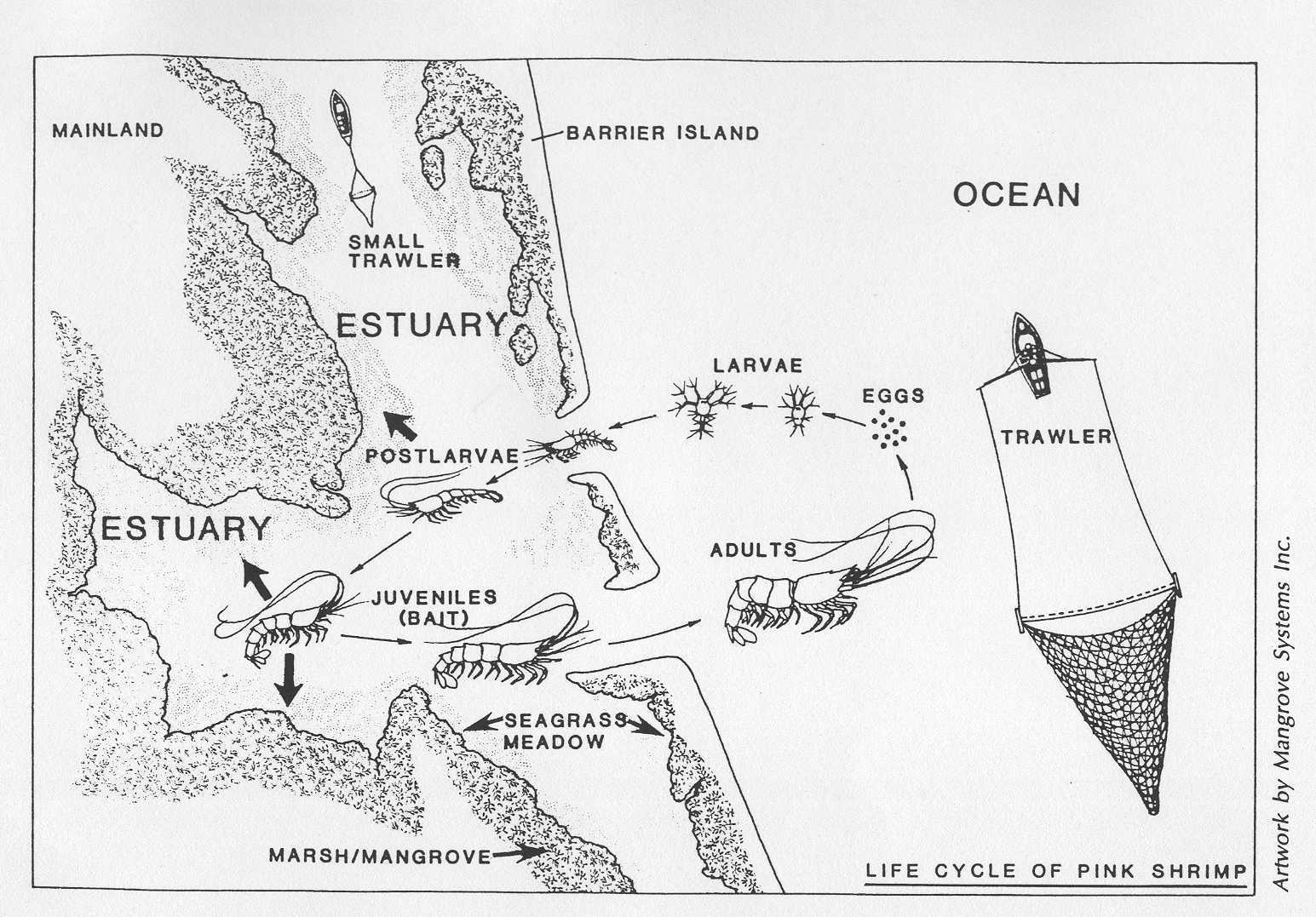Importance of insular seas
“America’s oceans and coasts are priceless assets. Indispensable to life itself, they also contribute significantly to our prosperity and overall quality of life. Too often, however, we take these gifts for granted, underestimating their value and ignoring our impact on them.” A
Wetland loss and restoration
"We can't just study environmental problems any more. We need to use science to inspire real change." b
Thesis
The loss of coastal wetlands, the pollution of estuaries, an accelerating rate of sea-level rising, and the centrality of estuarine marshes to coastal productivity combine to make protection and restoration of tidal marshes an effective means for adapting to the consequences of abrupt climate change, population growth, and increasing risks of property loss.
• centrality of estuarine marshes, sea grass beds, and shellfishery banks to coastal productivity
NRC
The National Research Council (1997) reported that 85% of commercially harvested fish depend on estuaries and nearshore habitats for at least one life stage. The NCCR II report (EPA 2004) indicates this value may be even higher - 95% of commercial fish and 85% of recreational fish use coastal wetlands and estuarine habitats.
p. 13.
National Marine Fisheries Service (NMFS) analysis, prepared in 1992
using fishery statistics from the 1980s, reported that estuarine species comprise a
substantial portion of commercial and recreational landings by weight—an average of
75% nationally with a maximum of 98% in the Gulf of Mexico (Chambers 1992).
• loss of coastal wetlands,
The result has been a loss of more than half of the nations' wetlands over the past 200 years1.
Late 20th century 1998-204: "experienced a net loss of 59,000 acres a year during that time period."
Estuarine Fish and Shellfish Species in U.S. Commercial and Recreational Fisheries: Economic Value as an Incentive to Protect and Restore Estuarine Habitat. p. 4.
National Wetland Research Center (NWRC) in Lafayette, Louisiana. The NWRC found that:
• Louisiana lost approximately 1,900 square miles of coastal land from 1932 to 2000.David E. Dismukes, Michelle L. Barnett, Kristi A. R. Darby, "Determining the Economic Value of Coastal Preservation and Restoration on Critical Energy Infrastructure," in The Economic and Market Value of Coasts and Estuaries: What’s At Stake? p. 87.
• an accelerating rate of sea-level rising,
Taking at least some of this accelerated melting into account, a recent study suggests that a feasible range by 2100 might be 20 inches to 4 ½ feet with a 9 degree Fahrenheit warming relative to 1990 levels, which is within the range of projected warming during this century if global warming pollution continues unabated (Rahmstorf, 2007). 6
With its expansive coastline, low-lying topography, and growing coastal population, the Chesapeake Bay region is one of the most vulnerable places in the nation to the impacts of sea-level rise. Many places along the Chesapeake Bay have seen a one-foot increase in relative sea-level rise over the 20th century, six inches due to global warming and other six inches due to naturally subsiding coastal lands – a factor that places the Chesapeake Bay region at particular risk (Zervas, 2001) that determine changes in vertical land elevation, such as land subsidence, sedimentation, and marsh accretion. Already, many of the bay’s coastal marshes and small islands have been inundated. At least 13 islands in the bay have disappeared entirely, and many more are at risk of being lost soon.
(U.S. EPA, 2008)
√ protection and restoration of tidal marshes
an effective means for adapting to the consequences of abrupt climate change,
population growth, and increasing risks of property loss.
Estuarine pollution:
The pollution of estuaries throughout the United States is an accelerating problem due to urban & agricultural runoff and failure of municipal waste water treatment to keep pace with science and technology.
This report is the culmination of almost seven years of effort to assess comprehensively the scale, scope, and characteristics of nutrient enrichment and eutrophic conditions in the nation's estuaries. It provides the most comprehensive assessment of these issues ever assembled for our nation's estuaries. The results represent a significant contribution to the development of a national strategy to control nutrient enrichment problems. The assessment includes evaluations of eutrophic conditions, impaired estuarine uses, influence of humans, future conditions, data gaps, and research needs.2
Arguments
economic activity and value generated
√ key sectors are coasts and estuaries:
Healthy coasts support jobs and wages, and improve housing values. Estuaries continue to be important producers of seafood and are the hubs of the nation’s international trade. Coasts provide recreational opportunities for nearly half of all Americans, generating tens of billions of dollars of economic value—far more value than is commonly recognized. Coasts also are home to a large share of the nation's energy refining and distribution infrastructure. The health of coastal ecosystems, especially coastal wetlands, directly affects the economic vitality and resilience of the U.S. gas and petroleum industry.3
Evidence
"Coastal estuaries include a variety of geophysical structures, including coastal plain estuaries (Chesapeake Bay), tectonic estuaries (San Francisco Bay), bar-built estuaries that form lagoons or bays (Barataria-Terrebonne), and fjords (Kenai). One common feature of estuaries is the presence of complex hydrodynamic and nutrient fluxes that
result from the intermixing of fresh and saline waters. This intermixing creates salinity gradients that allow for the survival of a rich array of fauna and flora." 4
Types of Services
A. five supportive services and five regulating services provided by estuaries.
A.1. supportive services are:
- nutrients,
- soil,
- biological wealth,
- habitat,
- hydrological cycle
A.2. regulating services:
- gas exchange,
- climate,
- disturbance regulation,
- soil retention,
- waste assimilation
pp. 16-17.
Matrix of qualitative values
| hydrological cycle | habitat | biological wealth | soil | nutrients |
| gas exchange | ||||
| climate, | ||||
| disturbance regulation | soil retention | |||
| waste assimilation |
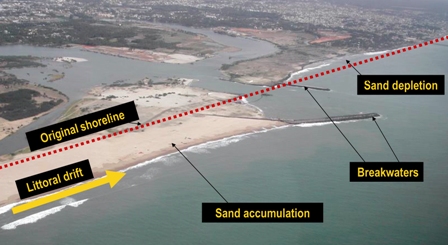
Economic estimations
Peconic Estuary of Long Island
"Based on responses to contingent choice questions developed by the authors, the average estimated annual per-acre dollar values (original estimates are inflated to $2005 using the consumer price index) were $5,760 for unpolluted shellfish grounds, $6,144 for saltmarsh, and $7,680 for eelgrass beds. Aggregated over a 25-year time horizon at a 7% discount rate, the net present values per acre ranged from $39,680 to protect safe shellfishing areas to $108,800 to protect eelgrass."
(Opaluch et. al. 1999; p.117). 5
"It is apparent that the estuary regions comprise a very significant portion of the total United States economy. The estuary regions make up about 12.6% of the area of the continental United States, but on that relatively small area can be found nearly 43% of the U.S. population, about 40% of employment, and almost half (49%) of the output of the U.S. economy."
Charles S. Colgan, "The Value of Estuary Regions in the U.S. Economy," in The Economic and Market Value of Coasts and Estuaries: What’s At Stake? pp. 44-45.
"With only 13% of the land area of the continental U.S., the estuary regions of the United States comprise a hugely disproportionate share of the national economy, with 43% of population, 40% of employment, and 49% of output. In eight states, the estuary regions comprise 80% or more of the state’s economy, and these regions comprise more than half of the state’s economy in 14 states. The economic “footprint” of estuary regions is thus significant throughout the county, and restoring the health of estuaries is a matter of concern to the health of a large part of the economy."
Charles S. Colgan, "The Value of Estuary Regions in the U.S. Economy," in The Economic and Market Value of Coasts and Estuaries: What’s At Stake? p. 63.
Status:
Coastal estuaries around the world are currently undergoing significant pressures caused by human population growth (Agardy et al. 2005). Approximately 44% of the global population in 1994 lived within 150 km of a coastline (Cohen et al. 1997). Today, that trend appears to be accelerating. Already, more than half of the U.S. population lives along the coast and in coastal watersheds (Beach 2002).
For example, in Chapter 3, Colgan finds that more than 43% of the nation’s population resides in counties with estuaries. Coastal states are among the nation’s fastest growing and are expected to experience most of the absolute growth in population in the decades ahead (Beatley et al. 2002).
Humans are now a major agent influencing the morphology and ecology of the coastal zone, either directly by means of engineering and construction works and/or indirectly by modifying the physical, biological and chemical processes at work within the coastal system (Townend 2002).
p. 20.
"Ecosystem goods and services form a fundamental connective link between people and coastal estuarine systems."
p. 32.
Definitions:
“Eustatic” sea-level rise refers to the changes in ocean volume due to thermal expansion and melting glaciers and ice sheets. At the localized level, the amount of relative sea-level rise can vary due to factors (both natural -- for instance erosion, and human influenced -- such as pumping ground water.)
Estuarine circulation; mixing zone, null zone
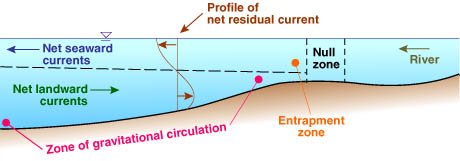
The area in an estuary where counter currents and divergent density of water bodies acts to hold nutrients and suspended solids and thus strand or trap their movement from further mixing with ocean water in the form of the salt wedge that moves in river mouths with respect to the tides of a particular coast.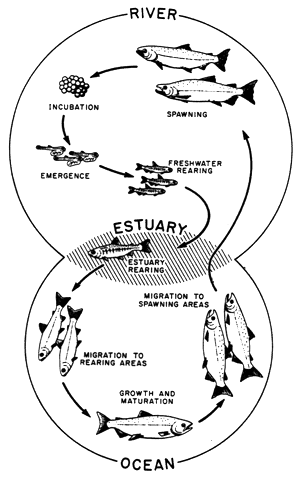
http://sfbay.wr.usgs.gov/sediment/circulation/circulation_revised.html
primary productivity for ocean life:
Measured in terms of the number of whales that could be sustained by the capacity of the Estuary to produce plankton as food for grazing whales.
San Francisco Bay |
equivalent |
productivity |
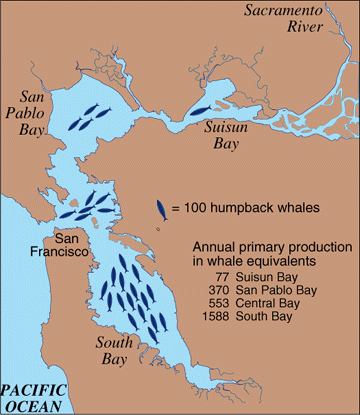 |
77 | Suisun Bay |
| 370 | San Pablo Bay | |
| 553 | Golden Gate | |
| 1589 | South Bay | |
2589 |
total |
How primary productivity is measured.
K. A. Lellis-Dibble, K. E. McGlynn, and T. E. Bigford, "Estuarine Fish and Shellfish Species in U.S. Commercial and Recreational Fisheries:Economic Value as an Incentive to Protect and Restore
Estuarine Habitat"
National Oceanic and Atmospheric Administration
National Marine Fisheries Service
Office of Habitat Conservation
Habitat Protection Division
November 2008
NOAA Technical Memorandum NMFS-F/SPO-90
An Ocean Blueprint for the 21st Century: Final Report of the U.S. Commission on Ocean Policy,
Recognizing Ocean Assets and Challenges, page 1.
The University of Maryland Center for Environmental Science
The National Marine Fisheries Service, "estimate: 20__"
"National estuarine eutrophication assessment: effects of nutrient enrichment in the nation's estuaries." Bricker, S.B.; Clement, C.G.; Pirhalla, D.E.; Orlando, S.P.; Farrow, D.R.G. (1999).
Linwood Pendleton, "The Economic and Market Value of Coasts and Estuaries: What’s At Stake?", p. 2.
Mathew Wilson & Stephen Farber, "The Economic and Market Value of Coasts and Estuaries: What’s At Stake?" p. 14.
Mathew Wilson & Stephen Farber, "The Economic and Market Value of Coasts and Estuaries: What’s At Stake?" pp. 29-30.
Patty Glick, et. al. "Sea-Level Rise and Coastal Habitats in the Chesapeake Bay Region," National Wildlife Federation; Technical Report: May 2008. pp. 2-3.
On loss of island in the bay: Sea-Level Rise and Coastal Habitats in the Chesapeake Bay Region, p. 3.

